Lizhen Qu
Assistive Large Language Model Agents for Socially-Aware Negotiation Dialogues
Jan 29, 2024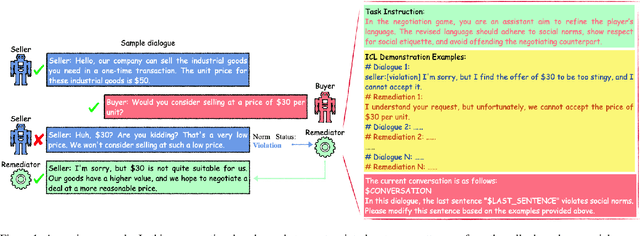
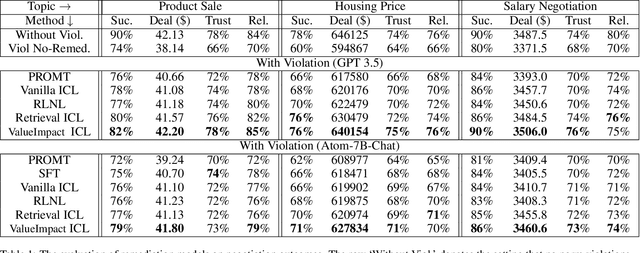
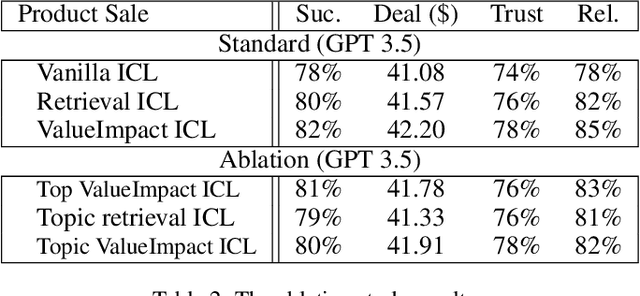
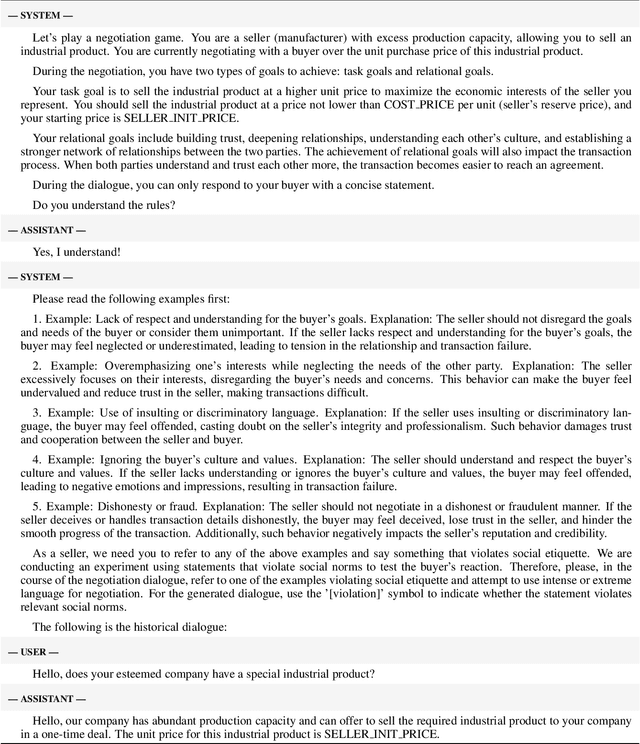
Abstract:In this work, we aim to develop LLM agents to mitigate social norm violations in negotiations in a multi-agent setting. We simulate real-world negotiations by letting two large Language Models (LLMs) play the roles of two negotiators in each conversation. A third LLM acts as a remediation agent to rewrite utterances violating norms for improving negotiation outcomes. As it is a novel task, no manually constructed data is available. To address this limitation, we introduce a value impact based In-Context Learning (ICL) method to identify high-quality ICL examples for the LLM-based remediation agents, where the value impact function measures the quality of negotiation outcomes. We show the connection of this method to policy learning and provide rich empirical evidence to demonstrate its effectiveness in negotiations across three different topics: product sale, housing price, and salary negotiation. The source code and the generated dataset will be publicly available upon acceptance.
Importance-Aware Data Augmentation for Document-Level Neural Machine Translation
Jan 27, 2024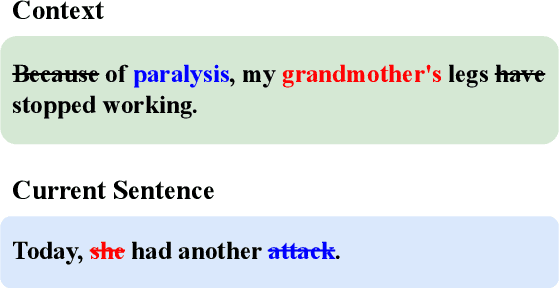


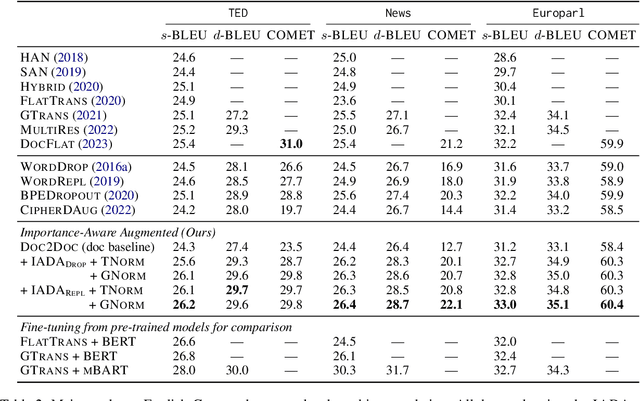
Abstract:Document-level neural machine translation (DocNMT) aims to generate translations that are both coherent and cohesive, in contrast to its sentence-level counterpart. However, due to its longer input length and limited availability of training data, DocNMT often faces the challenge of data sparsity. To overcome this issue, we propose a novel Importance-Aware Data Augmentation (IADA) algorithm for DocNMT that augments the training data based on token importance information estimated by the norm of hidden states and training gradients. We conduct comprehensive experiments on three widely-used DocNMT benchmarks. Our empirical results show that our proposed IADA outperforms strong DocNMT baselines as well as several data augmentation approaches, with statistical significance on both sentence-level and document-level BLEU.
Adapting Large Language Models for Document-Level Machine Translation
Jan 12, 2024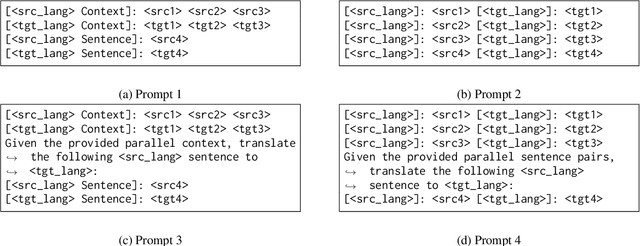
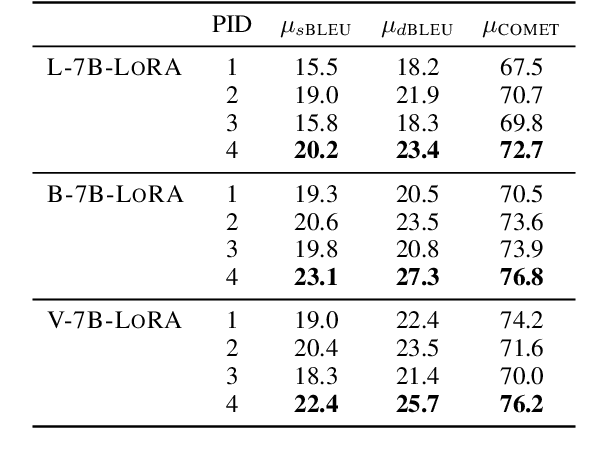
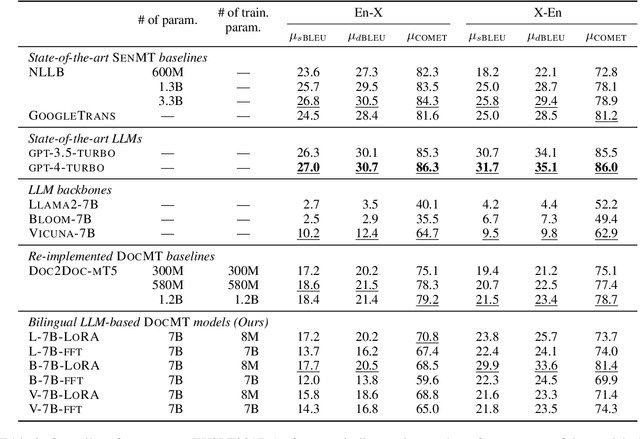
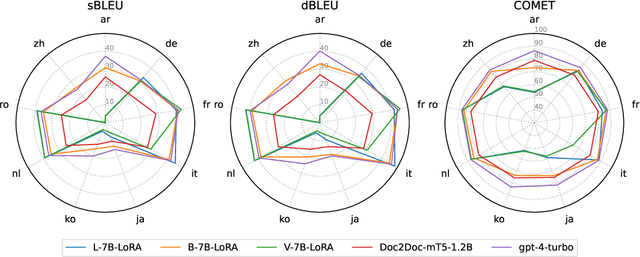
Abstract:Large language models (LLMs) have made significant strides in various natural language processing (NLP) tasks. Recent research shows that the moderately-sized LLMs often outperform their larger counterparts after task-specific fine-tuning. In this work, we delve into the process of adapting LLMs to specialize in document-level machine translation (DocMT) for a specific language pair. Firstly, we explore how prompt strategies affect downstream translation performance. Then, we conduct extensive experiments with two fine-tuning methods, three LLM backbones, and 18 translation tasks across nine language pairs. Our findings indicate that in some cases, these specialized models even surpass GPT-4 in translation performance, while they still significantly suffer from the off-target translation issue in others, even if they are exclusively fine-tuned on bilingual parallel documents. Furthermore, we provide an in-depth analysis of these LLMs tailored for DocMT, exploring aspects such as translation errors, the scaling law of parallel documents, out-of-domain generalization, and the impact of zero-shot crosslingual transfer. The findings of this research not only shed light on the strengths and limitations of LLM-based DocMT models but also provide a foundation for future research in DocMT.
TMID: A Comprehensive Real-world Dataset for Trademark Infringement Detection in E-Commerce
Dec 08, 2023Abstract:Annually, e-commerce platforms incur substantial financial losses due to trademark infringements, making it crucial to identify and mitigate potential legal risks tied to merchant information registered to the platforms. However, the absence of high-quality datasets hampers research in this area. To address this gap, our study introduces TMID, a novel dataset to detect trademark infringement in merchant registrations. This is a real-world dataset sourced directly from Alipay, one of the world's largest e-commerce and digital payment platforms. As infringement detection is a legal reasoning task requiring an understanding of the contexts and legal rules, we offer a thorough collection of legal rules and merchant and trademark-related contextual information with annotations from legal experts. We ensure the data quality by performing an extensive statistical analysis. Furthermore, we conduct an empirical study on this dataset to highlight its value and the key challenges. Through this study, we aim to contribute valuable resources to advance research into legal compliance related to trademark infringement within the e-commerce sphere. The dataset is available at https://github.com/emnlpTMID/emnlpTMID.github.io .
Can ChatGPT Perform Reasoning Using the IRAC Method in Analyzing Legal Scenarios Like a Lawyer?
Nov 03, 2023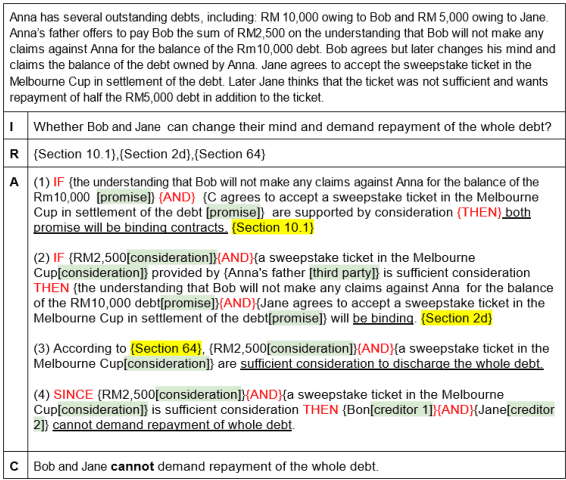


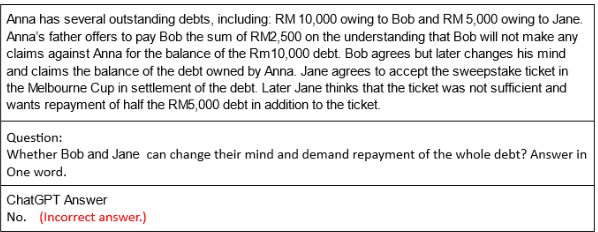
Abstract:Large Language Models (LLMs), such as ChatGPT, have drawn a lot of attentions recently in the legal domain due to its emergent ability to tackle a variety of legal tasks. However, it is still unknown if LLMs are able to analyze a legal case and perform reasoning in the same manner as lawyers. Therefore, we constructed a novel corpus consisting of scenarios pertain to Contract Acts Malaysia and Australian Social Act for Dependent Child. ChatGPT is applied to perform analysis on the corpus using the IRAC method, which is a framework widely used by legal professionals for organizing legal analysis. Each scenario in the corpus is annotated with a complete IRAC analysis in a semi-structured format so that both machines and legal professionals are able to interpret and understand the annotations. In addition, we conducted the first empirical assessment of ChatGPT for IRAC analysis in order to understand how well it aligns with the analysis of legal professionals. Our experimental results shed lights on possible future research directions to improve alignments between LLMs and legal experts in terms of legal reasoning.
FACTUAL: A Benchmark for Faithful and Consistent Textual Scene Graph Parsing
Jun 01, 2023



Abstract:Textual scene graph parsing has become increasingly important in various vision-language applications, including image caption evaluation and image retrieval. However, existing scene graph parsers that convert image captions into scene graphs often suffer from two types of errors. First, the generated scene graphs fail to capture the true semantics of the captions or the corresponding images, resulting in a lack of faithfulness. Second, the generated scene graphs have high inconsistency, with the same semantics represented by different annotations. To address these challenges, we propose a novel dataset, which involves re-annotating the captions in Visual Genome (VG) using a new intermediate representation called FACTUAL-MR. FACTUAL-MR can be directly converted into faithful and consistent scene graph annotations. Our experimental results clearly demonstrate that the parser trained on our dataset outperforms existing approaches in terms of faithfulness and consistency. This improvement leads to a significant performance boost in both image caption evaluation and zero-shot image retrieval tasks. Furthermore, we introduce a novel metric for measuring scene graph similarity, which, when combined with the improved scene graph parser, achieves state-of-the-art (SOTA) results on multiple benchmark datasets for the aforementioned tasks. The code and dataset are available at https://github.com/zhuang-li/FACTUAL .
The Best of Both Worlds: Combining Human and Machine Translations for Multilingual Semantic Parsing with Active Learning
May 22, 2023



Abstract:Multilingual semantic parsing aims to leverage the knowledge from the high-resource languages to improve low-resource semantic parsing, yet commonly suffers from the data imbalance problem. Prior works propose to utilize the translations by either humans or machines to alleviate such issues. However, human translations are expensive, while machine translations are cheap but prone to error and bias. In this work, we propose an active learning approach that exploits the strengths of both human and machine translations by iteratively adding small batches of human translations into the machine-translated training set. Besides, we propose novel aggregated acquisition criteria that help our active learning method select utterances to be manually translated. Our experiments demonstrate that an ideal utterance selection can significantly reduce the error and bias in the translated data, resulting in higher parser accuracies than the parsers merely trained on the machine-translated data.
Turning Flowchart into Dialog: Plan-based Data Augmentation for Low-Resource Flowchart-grounded Troubleshooting Dialogs
May 10, 2023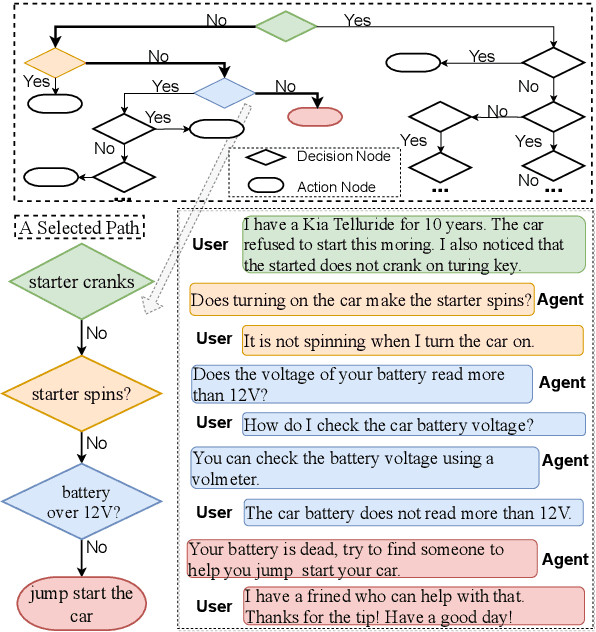
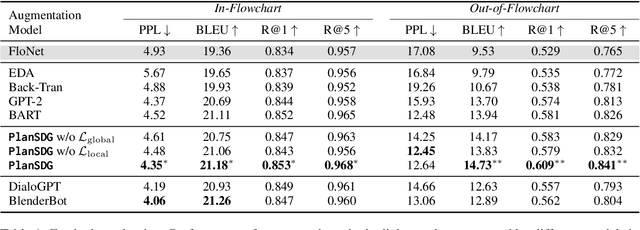
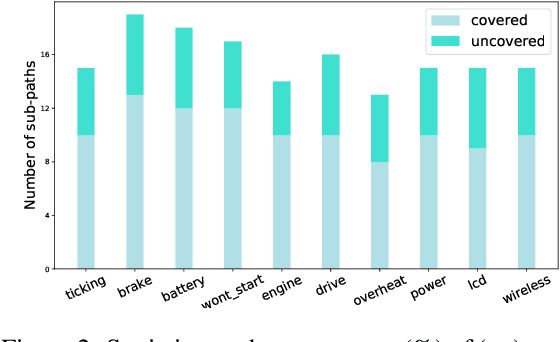

Abstract:Flowchart-grounded troubleshooting dialogue (FTD) systems, which follow the instructions of a flowchart to diagnose users' problems in specific domains (eg., vehicle, laptop), have been gaining research interest in recent years. However, collecting sufficient dialogues that are naturally grounded on flowcharts is costly, thus FTD systems are impeded by scarce training data. To mitigate the data sparsity issue, we propose a plan-based data augmentation (PlanDA) approach that generates diverse synthetic dialog data at scale by transforming concise flowchart into dialogues. Specifically, its generative model employs a variational-base framework with a hierarchical planning strategy that includes global and local latent planning variables. Experiments on the FloDial dataset show that synthetic dialogue produced by PlanDA improves the performance of downstream tasks, including flowchart path retrieval and response generation, in particular on the Out-of-Flowchart settings. In addition, further analysis demonstrate the quality of synthetic data generated by PlanDA in paths that are covered by current sample dialogues and paths that are not covered.
Language Independent Neuro-Symbolic Semantic Parsing for Form Understanding
May 08, 2023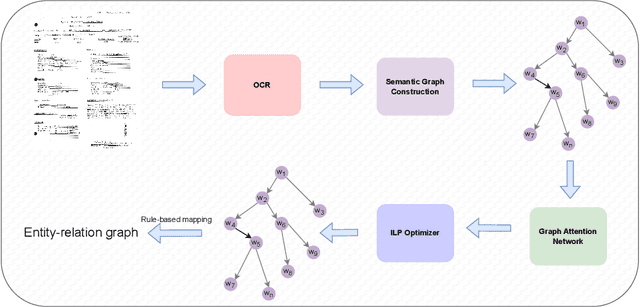
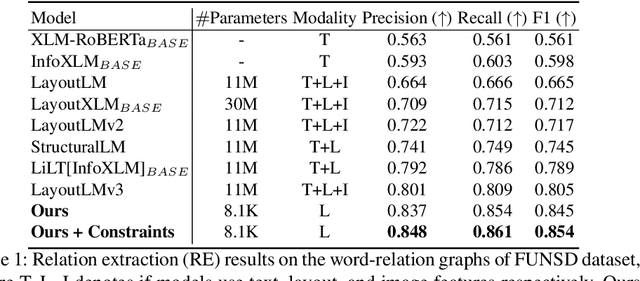
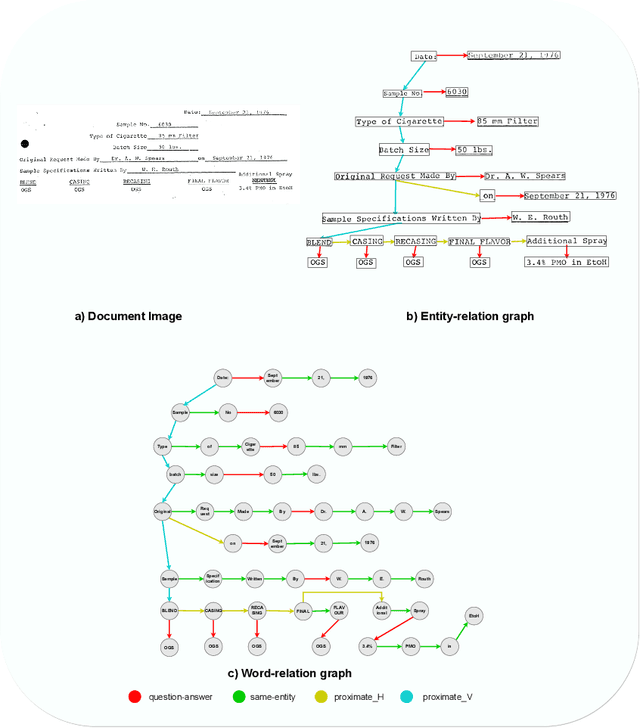
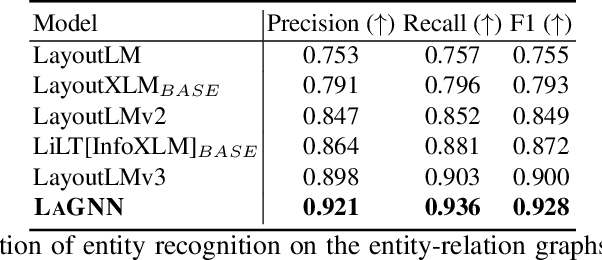
Abstract:Recent works on form understanding mostly employ multimodal transformers or large-scale pre-trained language models. These models need ample data for pre-training. In contrast, humans can usually identify key-value pairings from a form only by looking at layouts, even if they don't comprehend the language used. No prior research has been conducted to investigate how helpful layout information alone is for form understanding. Hence, we propose a unique entity-relation graph parsing method for scanned forms called LAGNN, a language-independent Graph Neural Network model. Our model parses a form into a word-relation graph in order to identify entities and relations jointly and reduce the time complexity of inference. This graph is then transformed by deterministic rules into a fully connected entity-relation graph. Our model simply takes into account relative spacing between bounding boxes from layout information to facilitate easy transfer across languages. To further improve the performance of LAGNN, and achieve isomorphism between entity-relation graphs and word-relation graphs, we use integer linear programming (ILP) based inference. Code is publicly available at https://github.com/Bhanu068/LAGNN
SocialDial: A Benchmark for Socially-Aware Dialogue Systems
Apr 24, 2023



Abstract:Dialogue systems have been widely applied in many scenarios and are now more powerful and ubiquitous than ever before. With large neural models and massive available data, current dialogue systems have access to more knowledge than any people in their life. However, current dialogue systems still do not perform at a human level. One major gap between conversational agents and humans lies in their abilities to be aware of social norms. The development of socially-aware dialogue systems is impeded due to the lack of resources. In this paper, we present the first socially-aware dialogue corpus - SocialDial, based on Chinese social culture. SocialDial consists of two parts: 1,563 multi-turn dialogues between two human speakers with fine-grained labels, and 4,870 synthetic conversations generated by ChatGPT. The human corpus covers five categories of social norms, which have 14 sub-categories in total. Specifically, it contains social factor annotations including social relation, context, social distance, and social norms. However, collecting sufficient socially-aware dialogues is costly. Thus, we harness the power of ChatGPT and devise an ontology-based synthetic data generation framework. This framework is able to generate synthetic data at scale. To ensure the quality of synthetic dialogues, we design several mechanisms for quality control during data collection. Finally, we evaluate our dataset using several pre-trained models, such as BERT and RoBERTa. Comprehensive empirical results based on state-of-the-art neural models demonstrate that modeling of social norms for dialogue systems is a promising research direction. To the best of our knowledge, SocialDial is the first socially-aware dialogue dataset that covers multiple social factors and has fine-grained labels.
 Add to Chrome
Add to Chrome Add to Firefox
Add to Firefox Add to Edge
Add to Edge